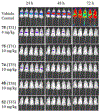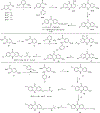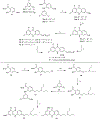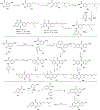Discovery and Structural Optimization of Acridones as Broad-Spectrum Antimalarials
- PMID: 30852885
- PMCID: PMC6822569
- DOI: 10.1021/acs.jmedchem.8b01961
Discovery and Structural Optimization of Acridones as Broad-Spectrum Antimalarials
Abstract
Malaria remains one of the deadliest diseases in the world today. Novel chemoprophylactic and chemotherapeutic antimalarials are needed to support the renewed eradication agenda. We have discovered a novel antimalarial acridone chemotype with dual-stage activity against both liver-stage and blood-stage malaria. Several lead compounds generated from structural optimization of a large library of novel acridones exhibit efficacy in the following systems: (1) picomolar inhibition of in vitro Plasmodium falciparum blood-stage growth against multidrug-resistant parasites; (2) curative efficacy after oral administration in an erythrocytic Plasmodium yoelii murine malaria model; (3) prevention of in vitro Plasmodium berghei sporozoite-induced development in human hepatocytes; and (4) protection of in vivo P. berghei sporozoite-induced infection in mice. This study offers the first account of liver-stage antimalarial activity in an acridone chemotype. Details of the design, chemistry, structure-activity relationships, safety, metabolic/pharmacokinetic studies, and mechanistic investigation are presented herein.
Conflict of interest statement
The authors declare no competing financial interest.
Figures







Similar articles
-
Lead Optimization of Second-Generation Acridones as Broad-Spectrum Antimalarials.J Med Chem. 2020 Jun 11;63(11):6179-6202. doi: 10.1021/acs.jmedchem.0c00539. Epub 2020 May 26. J Med Chem. 2020. PMID: 32390431 Free PMC article.
-
Development of Next-Generation Antimalarial Acridones with Radical Cure Potential.J Med Chem. 2025 Apr 24;68(8):8817-8840. doi: 10.1021/acs.jmedchem.5c00419. Epub 2025 Apr 3. J Med Chem. 2025. PMID: 40179277 Free PMC article.
-
Discovery of dual function acridones as a new antimalarial chemotype.Nature. 2009 May 14;459(7244):270-3. doi: 10.1038/nature07937. Epub 2009 Apr 8. Nature. 2009. PMID: 19357645 Free PMC article.
-
New approaches in antimalarial drug discovery and development: a review.Mem Inst Oswaldo Cruz. 2012 Nov;107(7):831-45. doi: 10.1590/s0074-02762012000700001. Mem Inst Oswaldo Cruz. 2012. PMID: 23147137 Review.
-
Comprehensive review on various strategies for antimalarial drug discovery.Eur J Med Chem. 2017 Jan 5;125:1300-1320. doi: 10.1016/j.ejmech.2016.11.025. Epub 2016 Nov 12. Eur J Med Chem. 2017. PMID: 27886547 Review.
Cited by
-
Boron Trifluoride Etherate Promoted Microwave-Assisted Synthesis of Antimalarial Acridones.RSC Adv. 2019;9(72):42284-42293. doi: 10.1039/c9ra09478d. Epub 2019 Dec 20. RSC Adv. 2019. PMID: 35321096 Free PMC article.
-
Lead Optimization of Second-Generation Acridones as Broad-Spectrum Antimalarials.J Med Chem. 2020 Jun 11;63(11):6179-6202. doi: 10.1021/acs.jmedchem.0c00539. Epub 2020 May 26. J Med Chem. 2020. PMID: 32390431 Free PMC article.
-
Development of Next-Generation Antimalarial Acridones with Radical Cure Potential.J Med Chem. 2025 Apr 24;68(8):8817-8840. doi: 10.1021/acs.jmedchem.5c00419. Epub 2025 Apr 3. J Med Chem. 2025. PMID: 40179277 Free PMC article.
-
Structure-activity relationships of Toxoplasma gondii cytochrome bc1 inhibitors.Expert Opin Drug Discov. 2022 Sep;17(9):997-1011. doi: 10.1080/17460441.2022.2096588. Epub 2022 Aug 8. Expert Opin Drug Discov. 2022. PMID: 35772172 Free PMC article.
-
Synthesis of novel cytotoxic tetracyclic acridone derivatives and study of their molecular docking, ADMET, QSAR, bioactivity and protein binding properties.Sci Rep. 2020 Nov 26;10(1):20720. doi: 10.1038/s41598-020-77590-1. Sci Rep. 2020. PMID: 33244007 Free PMC article.
References
-
- WHO. World malaria report. 2016.
-
- White NJ; Pukrittayakamee S; Hien TT; Faiz MA; Mokuolu OA; Dondorp AM. Malaria. Lancet 2014, 383, 723–735. - PubMed
Publication types
MeSH terms
Substances
Grants and funding
LinkOut - more resources
Full Text Sources

